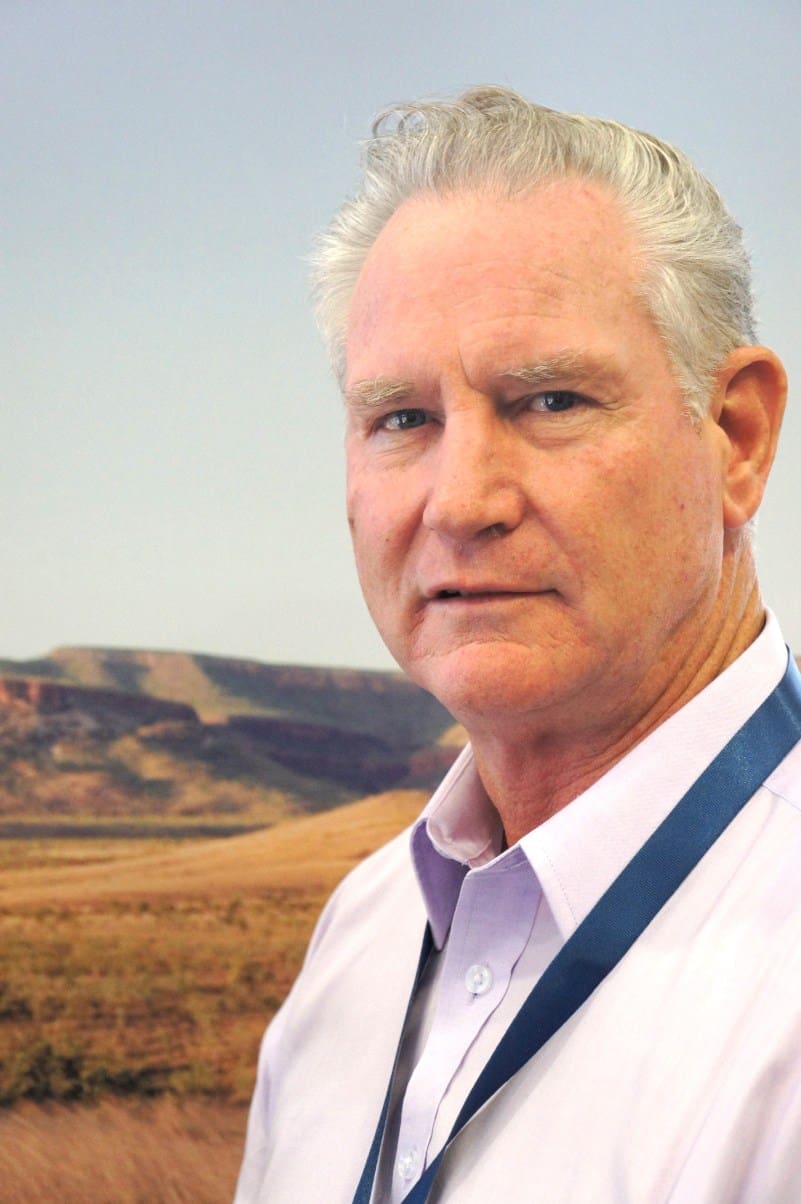
Terry McCosker
However our journey revealed a different story. Almost every dam we passed was by-washing, water was gushing off paddocks and down the gullies and the run-off was thick with silt. As we drove back 4 hours later, water was still sitting on top of the soil on the flats.
The entire landscape looked like it had been ploughed. It hadn’t been, it was just over stocked and overgrazed. My realization was that rainfall will not end the drought in this district, and this district is not on its own. That is a shocking condition for the national estate to be in.
That prompts the question – what caused the landscape to be in the condition it is in? Most people will say lack of rain, but I disagree. The condition of much of our landscape is a function of lack of effective management of the lack of rainfall – and not just the current drought. Getting a landscape to a hygroscopic state, has not just happened via this drought. It is an accumulation of mis-management over generations.
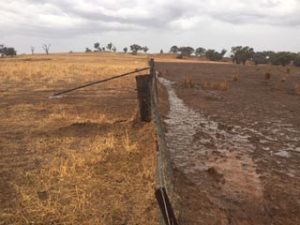 The property we visited was a clear example of the fact that it does not have to be like that. Here the water gushed off neighbouring farms and as it hit the grassed paddocks, the water infiltrated immediately and within 50m of the fence, it had all soaked in.
The property we visited was a clear example of the fact that it does not have to be like that. Here the water gushed off neighbouring farms and as it hit the grassed paddocks, the water infiltrated immediately and within 50m of the fence, it had all soaked in.
The tools and management practices which led to the stark contrast have been around for 30 years, including the 90’s drought, the 2003 drought and every other one since.
There is always a cost in a drought. The difficult thing is to restrict the cost to a financial one. However frequently, due to lack of a solid drought plan, there is a cost to the land, the livestock and the people in the business, on top of a financial loss. The losses compound which then takes away any opportunity to profit from the small falls of rain that do occur.
I was prompted to write this by an email received in response to Raymond Stacey’s last newsletter article. Here’s the email:
Dear RCS,
I read your newsletter ‘If you can’t see it, you can’t eat it’ with interest. I have driven between South East Queensland, the Northern Territory and northern Queensland on inland roads at various times during the previous three years, and been struck by the increasing amount of run-down country with cattle still on it, that I’ve seen over this time …
I have wondered what the point of this is and whether this type of land management is supported by the wider industry. To the outside eye it appears senseless for the reasons stated in your article… Your article made it clear how hard it is to manage large areas of land with insufficient and unreliable rainfall and I appreciated learning this. However, widespread run down country isn’t a good look for the industry, and unfortunately it is these areas I remember more than the country where grass and shrubs/trees are in tact. Even though it is by comparison with these areas that one concludes overstocking above drought, is causing this land degradation.
It is a good thing relatively few outside people travel through these areas. In my view it is a tragic vision, especially if degraded land is next to a national park, what the country could be and what it actually is. Not at all in line with the idea that Australian food is ‘green’. It is also a scene ready to be exploited by those who want to curtail the activities of the livestock industry. My sentiments and own interests are with the agricultural industries – my father was a farmer and I work in fruit packing sheds – however seeing this badly run down land has turned my sympathies away from graziers and I am sorry to say this.
I had not been drinking when this arrived, but if I had, it would have sobered me up quickly. This is from someone who is on our side but it clearly illustrates that the social licence for graziers to continue business as usual, is on the wane.
Further evidence of the slow withdrawal of the social licence to degrade land is the legislation being put through in Queensland, where policy has now switched from the carrot to the stick.
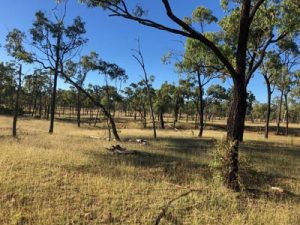
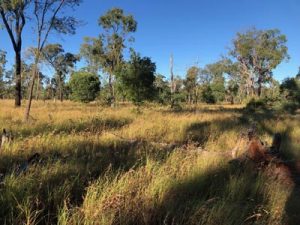
The photos above, taken by Raymond recently, illustrates what the author of the email was talking about. The first picture is Indian couch, a pioneer which thankfully protects degraded country. The second picture is in a nearby National Park and the Kangaroo grass, a high successional plant, is very evident. It is not the difference in yield which is important, because obviously one has been grazed. What is important are the indicators of the ecosystem health, such as the tree dieback, the indian couch, the browse line and the lack of shrubs, in the grazed country.
The following two properties are also in the same district and illustrate that it is not lack of rain that creates the environmental issues, but the management of the rainfall we get.
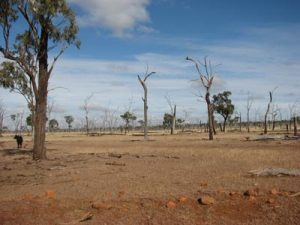
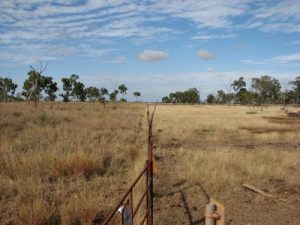
It is time we started to call a spade a bloody shovel.
We have national drought policy which rewards unsustainable management instead of encouraging future-focused management. We have extension systems which, in many cases, have encouraged poor drought strategies (e.g. drought feeding) rather than changing the status quo. It might be the circles I mix in but the vast majority of graziers do not want to be tarred by this brush and want drought policy reversed so it rewards good management instead of bad.
Unless this happens soon the chickens will come home to roost for the grazing industry with more legislation and no social licence to continue with business as usual.
Terry McCosker,
Transient part-owner of the National Estate.

The “Utah Initiatve” could double the amount of water in the Colorado River Impact of 1922.
I totally agree. Ex farmer and I totally agree. We need a paradigm shift. It just ain’t working at the moment. I live in Dubbo central NSW. I ride a motorbike at the weekends and do drought tour you might say , watching different regions different timber lines, and different management styles. The times are changing, climate change is real and we need to seriously need to get back to nature. Nature is the boss , not round up not the banks, We need to think about the young children. Cheers
As a city bloke I have guiltyly watched a news update about the terrible land conditions and thought “maybe the cattle shouldn’t be there”
What about that thing called science
https://m.phys.org/news/2019-09-plantations-rainfall.html
A great piece to read highlighting the FACT that drought is more manmade than weather related. Living and working on the land my entire life I have watched those around me/us as their farms dry and wither. Sadly many still ‘flog’ their country making bad decisions, bad practice and animal welfare, chemical warfare.
Bring on the practices of Peter Andrews, Savory Institute, Pat Coleby, Podilinsky or get off. Our country is dusting in the hands of malpractice.
These is no such thing as the National Estate and there is also no such thing as a Social License.These are poisonous concepts that would require a socialist government enforcing central planning,the collectivizing of the means of production starting with farms,and draconian enforcement of a multitude of regulations designed to coerce compliance.Some of these elements have already reared their ugly heads in Australian agriculture.There is also no such thing as a man made drought.Droughts are a result of an acute shortage of rainfall,a natural reoccurring event,aggravated by heat,frost and gale force winds.Farmers don’t need a national drought policy to reward “good management”,they need better prices.
Deny,deny, deny….same old same!
I have read this article with some concern. It seems to me there is a degree of over complication and maybe a lack of analysis of the numbers. Accordingly I would make the following observations
– analysis of the rainfall received over the last 6 to 8 years will reveal significant rainfall deficit and while this is not the only factor in the very debilitating drought I would contend it would be the most significant single factor.
– observation of mature trees that are dead or dying as a result of lack of rainfall would support that we are experiencing a sever drought.
– it appears that there has been little recognition of the impact of native and feral animals that also impact the feed reserves.
I would like to see the collective intellectual power of all in the industry directed to ensuring that we put in place “ a hand up “ for those families that have been afflicted by very severe drought for years to see that they remain and return to contribute to our industry going forward. We need every family kept in the industry, especially in central Australia, as i can not see any one being able to do a better job – most of us just don’t possess the fortitude required to persist in the very challenging enviroment that Australia can and is dishing up.
Disappointed in the comments from both writers Raymond and Terry as experienced rural advisers.
This extract from Raymond
” however seeing this badly run down land has turned my sympathies away from graziers and I am sorry to say this.”
This from Terry ” it clearly illustrates that the social licence for graziers to continue business as usual, is on the wane.”
While the visual experience is true, both comments are a slight on the majority .
The ELEPHANT in the room is The Financial system , in last decade (and longer)Bank actions have been nothing short of large scale corruption,the Royal Commission hardly touched the problem in the Rural sphere, where unconscionable actions on rural enterprises are STILL being used by lenders.
Borrowers should educate themselves on what happens to their Mortgages. (“it is well that the people of the nation do not understand our banking and monetary system for if they did there would be a revolution before tomorrow morning”)Henry Ford
One solution to combat the poor water cycle is to educate more widely.
Importantly the lenders, (bank boards, shareholders and those who exert financial pressure in particular).
Start with the effects of SDH/rain (Stock Days Ha/ml) compared to demanding unrealistic interest payments, Penalty rates, Forced sales, etc,etc.
Maybe this would be the catalyst to improve a Healthy Ecological Grazing Land and not leave it to the cash strapped
Grazier and Taxpayer.
The positive effect would be only curtailed by ones imagination.
Great article Terry, the evolution of new management practices and great innovative progressive ideas works at different speeds depending on people’s perception of the benefits.
Thank you, Terry. I hope your message goes beyond just the comprehension capacity of the “converted.”
Can I acknowledge Greg Brown (past president of CCA) – I see your earlier comment Greg. Maybe 2 to 3 years ago, Greg was interviewed on the ABC whilst attending a Northern field day. When asked what he considered the graziers’ biggest challenge was, he responded: “Reversing the run-down of the grasslands’ productive capacity.”
Dear Terry
Thank you for writing this article. The points you make are entirely accurate.
We have too many stakeholders now in ag (owning land) who do not hold a long-term view/perspective, and land being valued based upon unrealistic carrying capacities – though they claim to be validated.
Keep up the good work.
Cheers, Isobel
A very pertinent article. There are many reasons for inappropriate management. One that has not been mentioned is that a number of high profile farm management consultants put a high priority on financial bench-marking and maximizing the utilization of available forage by grazing. Both statagies can result in short term gain and long term pain in Australia’s variable climate.
Thank you Terry for this insightful and well supported argument that the emperor clearly has no clothes. IT IS time to change drought policy. It is time to look at incentives to destock early and manage land condition more sustainably. I hope you will bring your valuable experience to work with those who are actively trying to make a difference so that, into the future, we are not just talking about what we should be doing… But all, as an industry, doing it.
Terry’s assessment is right on the money. Seems to leave carbon neutrality high and dry
The key word here thank you Terry is Hygroscopic wether you are a grazier or cropping soil degradation starts and stops at the very definition of Hygroscopic. Way too many rainfall events are none effective. Why Hygroscopic.
Every morning all of us fail to see and understand the effects of Hygroscopic.
Consider the animals we nurture are smarter than human. We must be at piece with them.
Croppers please hang your kelly chains and other tools of mass destruction into the scrap metal dealer today not tomorrow.
The rules have changed. Everyone now must be prepared to wether a 3 year drought not two. This past one in most cases would be two and not going on three if we understood Hygroscopic and practised that.
We must think bio mass creation, utilisation and management regardless of the type of agricultural industry you’re in.
Banks should support those of who understand these ideas and stop funding bad land management practises.
A half smart greenie is going to eat us alive if we don’t all change.
This was a very interesting read; one I had come to the same conclusion but in my area, the Northern Rivers of NSW, it is hard to believe. Yes, we are in a green drought. I have watched my vealer weights decline and rearranged cattle as much as I could over the past 3 years. The truth is, I had better vealer weights when I ran less cattle despite how my late father would want to purport that our family farms could run a much higher stocking rate. WRONG. Yes we have have 3 bad years rainfall wise but I would like a management plan that caters for great seasons and terrible years (like the past 3 years), on balance.
At the same time as a bad 3 years (weather wise) I am looking to succession and diversion. I could not recommend to my successors a life in store weaners; it is way too unpredictable and despite trying the best cross breeding I could do, it isn’t good enough. I am totally jaded with the whole thing – and I love my cattle. Truth is, it is NOT sustainable and nor do I expect my successors, to try and maintain farms and earn a living, when markets, weather, and breeds sought are just to hard to react to, in the short term.
I am hoping that with my youngest son, macadamia trees we are currently planting will be my way into retirement (I don’t have Super) and his way out of having to work in maintenance in mine work in WA. He works at heights, welding suspended by ropes to earn the extra dollars that will hopefully allow him to fully set up back here with a dependable income from macadamias, unlike cattle where I have never been sure from sale to sale how much I would get. Truth is, during the current financial year, the only thing that has kept me financially aflaot is sale of cull cows from direct consignment to local meatworks. I would never recommend this life to any of my successors.
Ruth the sad part is overstocking makes u less competitive .
Great stuff Terry and via RCS you have been a wonderful advocate for and so successful educating many in how to better manage the land. Your point about the lack of water penetration on many properties is so true. I have recently been encouraged by the work of The Mulloon Institute especially about the importance of slowing the water-flow. This could be of interest to many and if so Google http://www.themullooninstitute.org
I believe that Terry’s assessment is indeed correct – and would be endorsed by Prof Walter Jehne who continues to encourage us all to nurture or regenerate what he terms “a moist soil carbon sponge.” A serious dose of Walter Jehne’s knowledge is in all probability an essential antidote for what we may now term “a Roland Garos tennis court?” It is a large tennis court now.
From the time I was a small child over 70 years ago, I have been on the land in far western Qld. I am also very aware of land management, stocking rates, and droughts, and hopefully, a conservationist who looks at both sides of the picture.
I totally agree with you Terry McCoster. Thank you for bringing your thoughts into the picture.
Very little is what it seems
It would be interesting to consider the reasons why some Australian farmers need to overstock. Firstly they have to compete with heavily subsidised overseas countries. Secondly our O.H and S laws are stifling and expensive, along with the green and red tape farmers have to deal with and thirdly our wages and costs, e.g. electricity, are unsustainable.